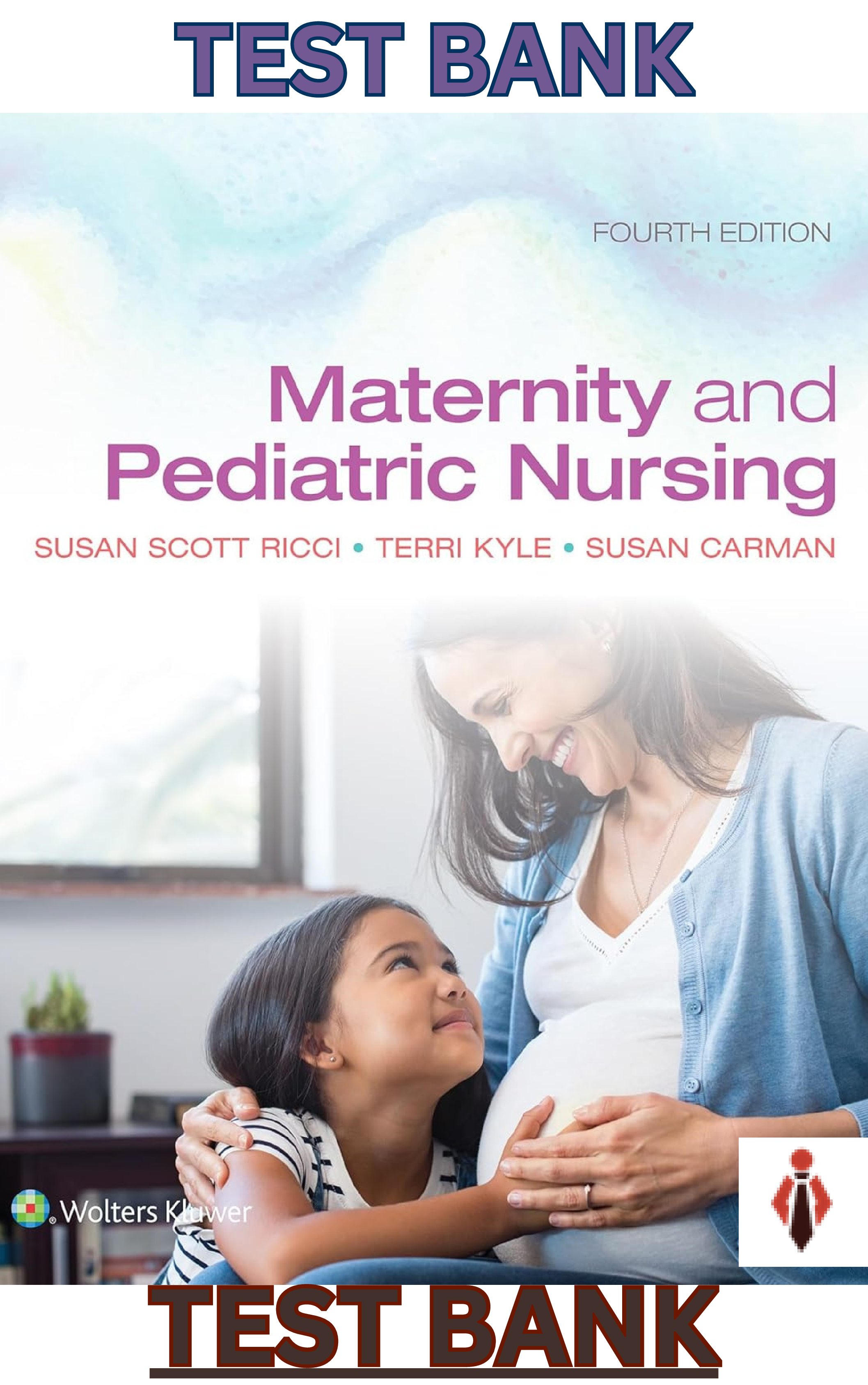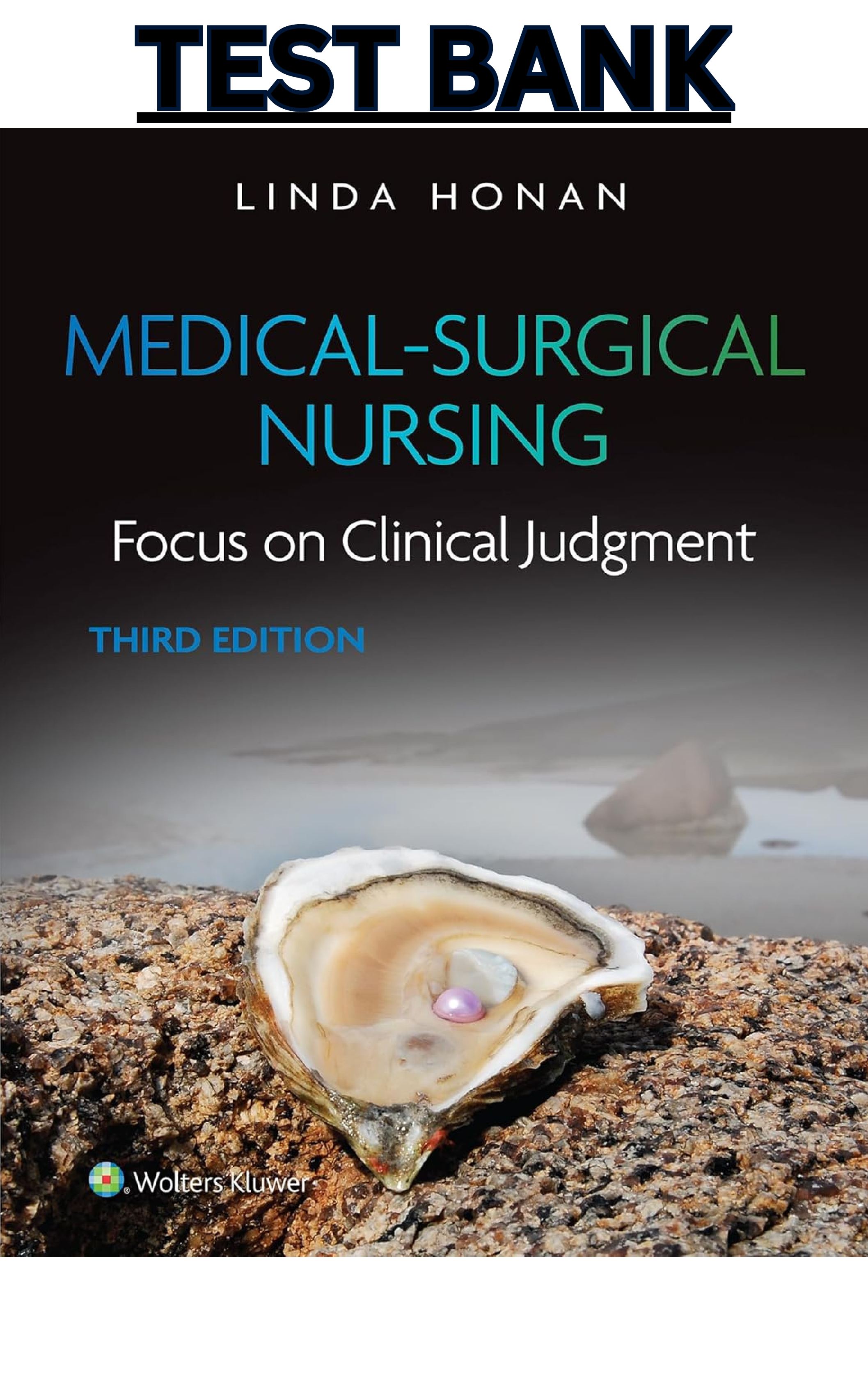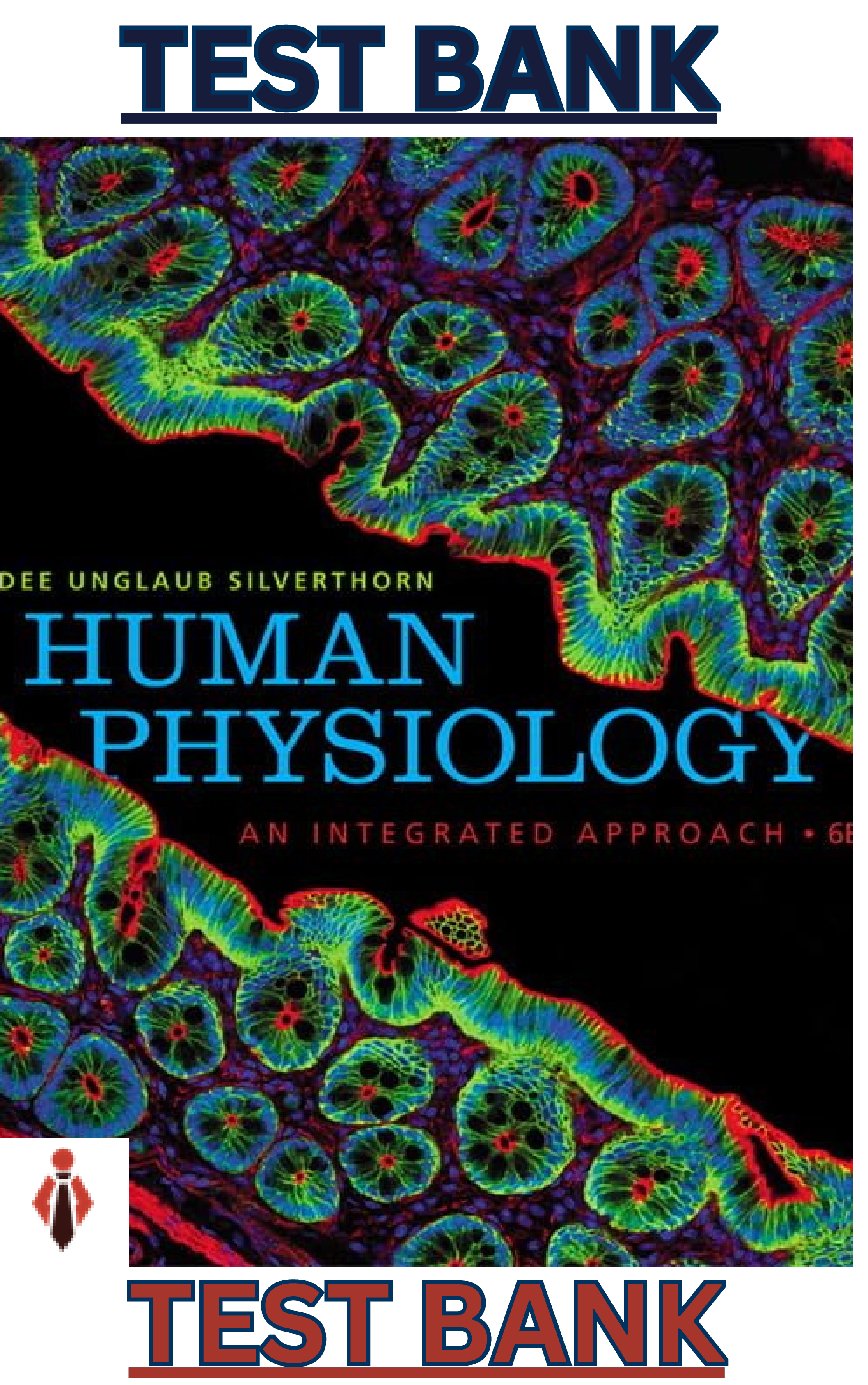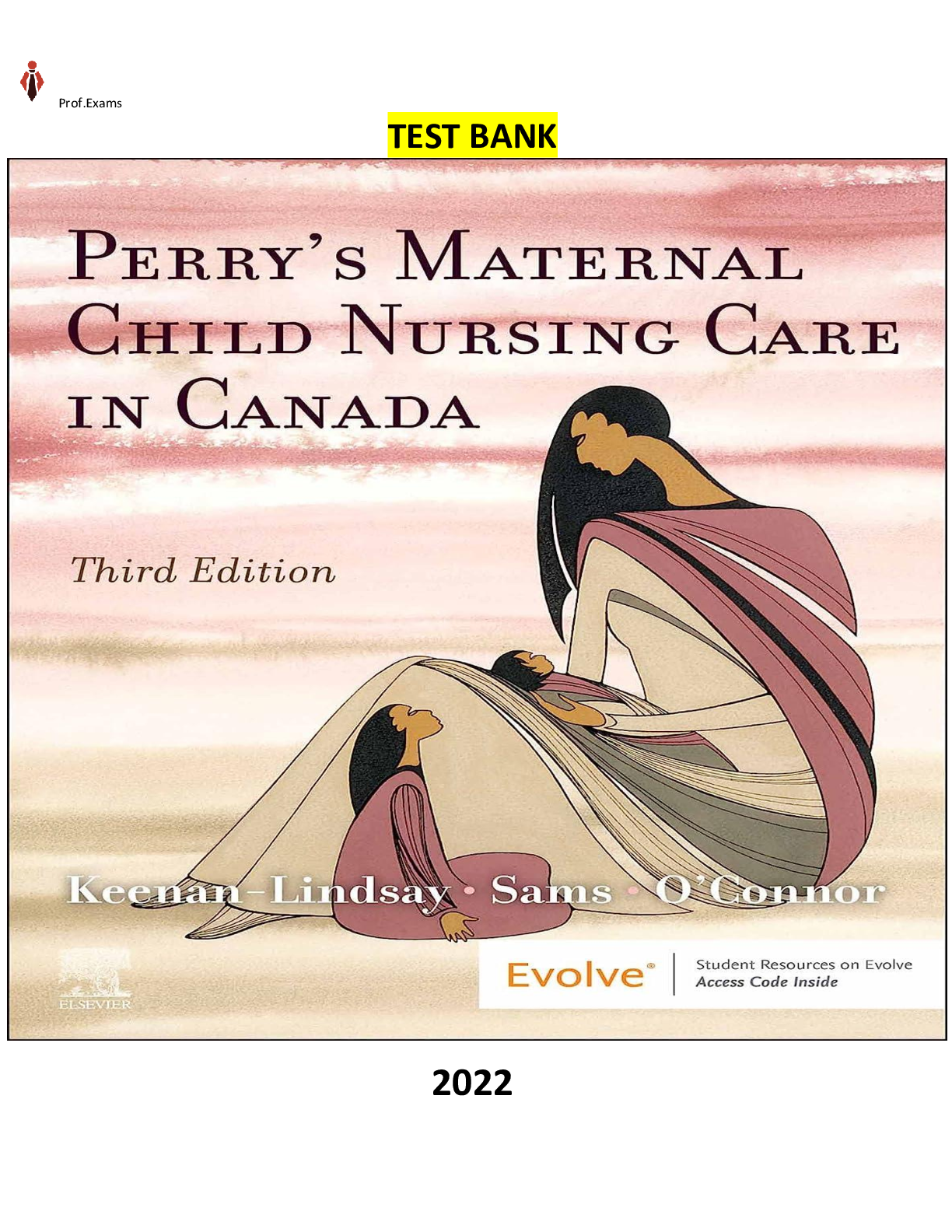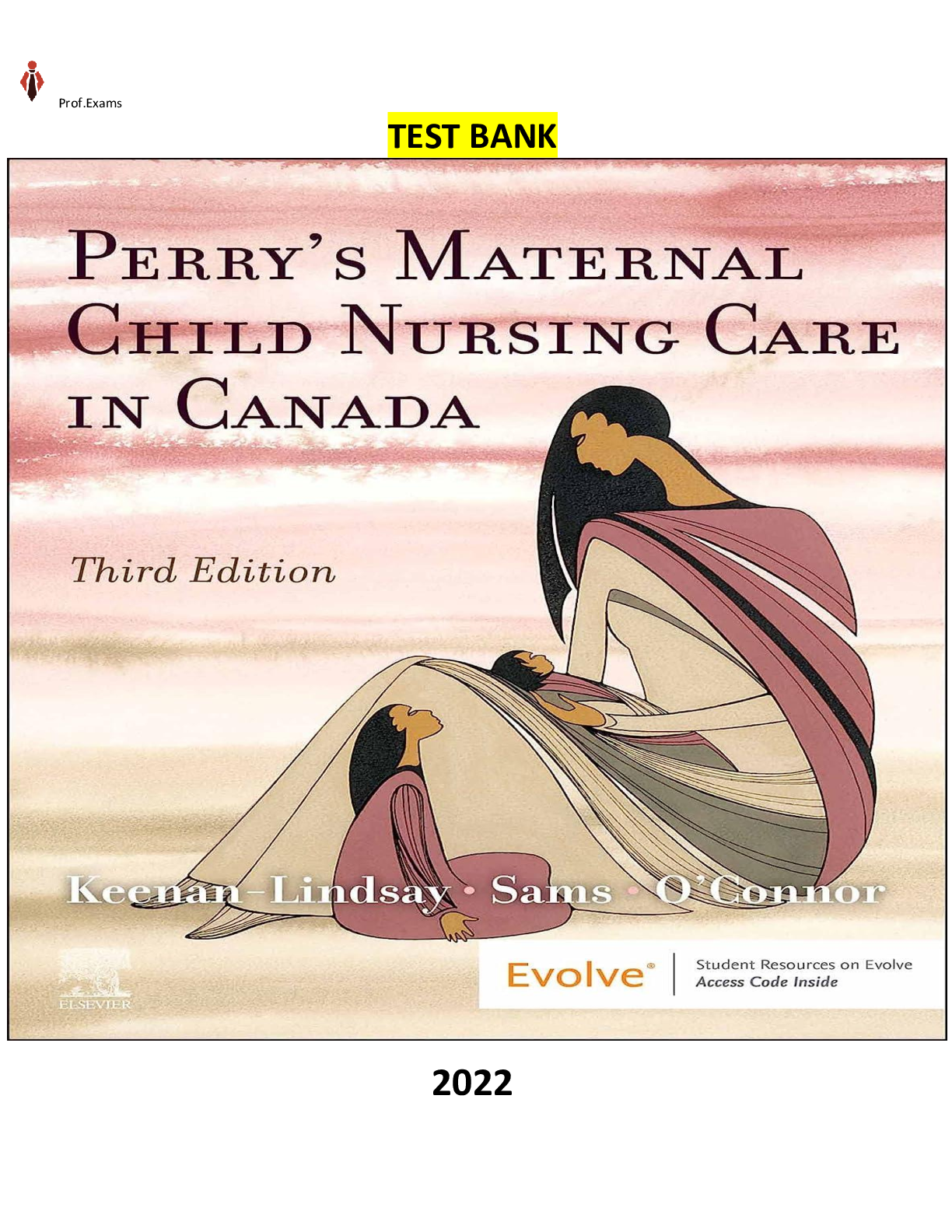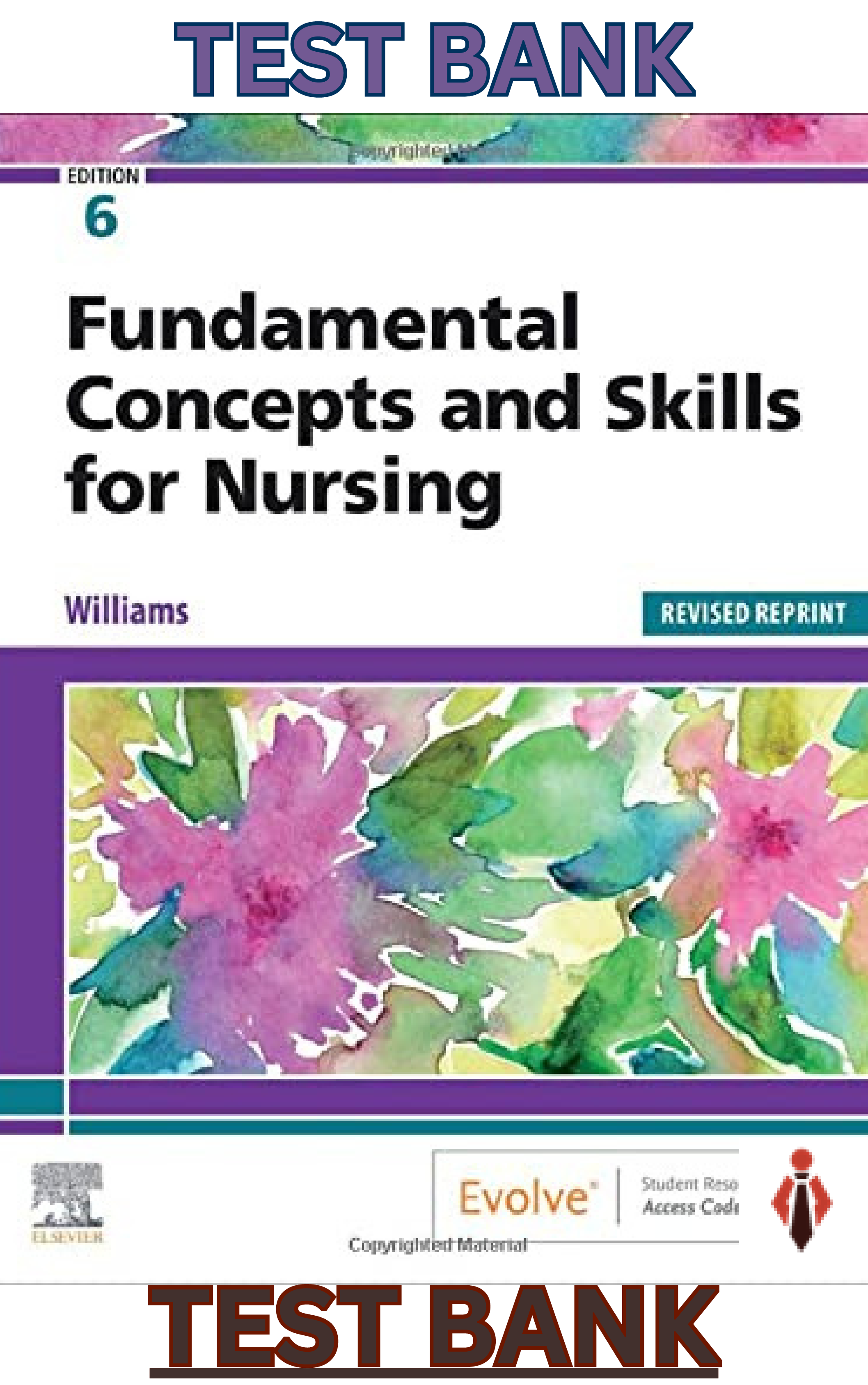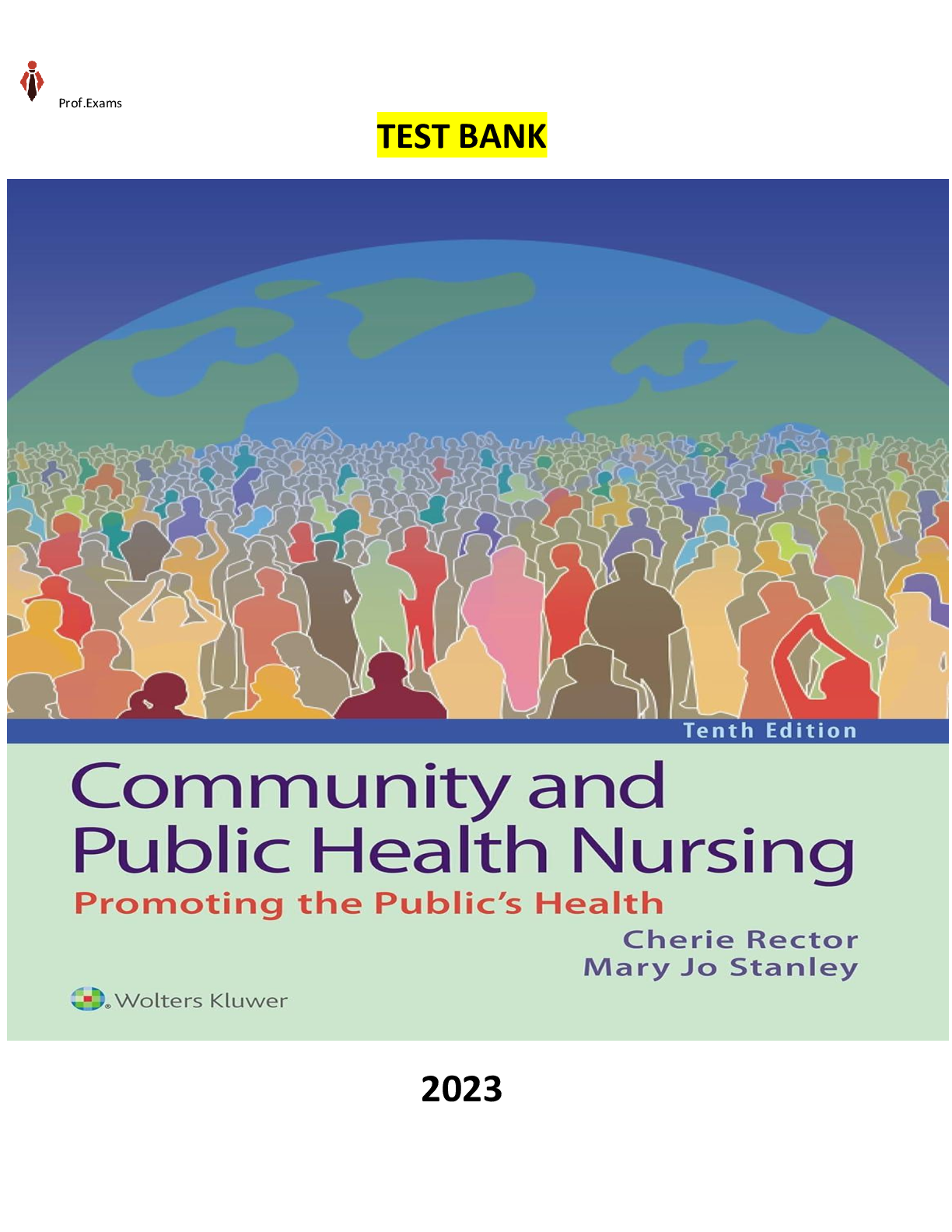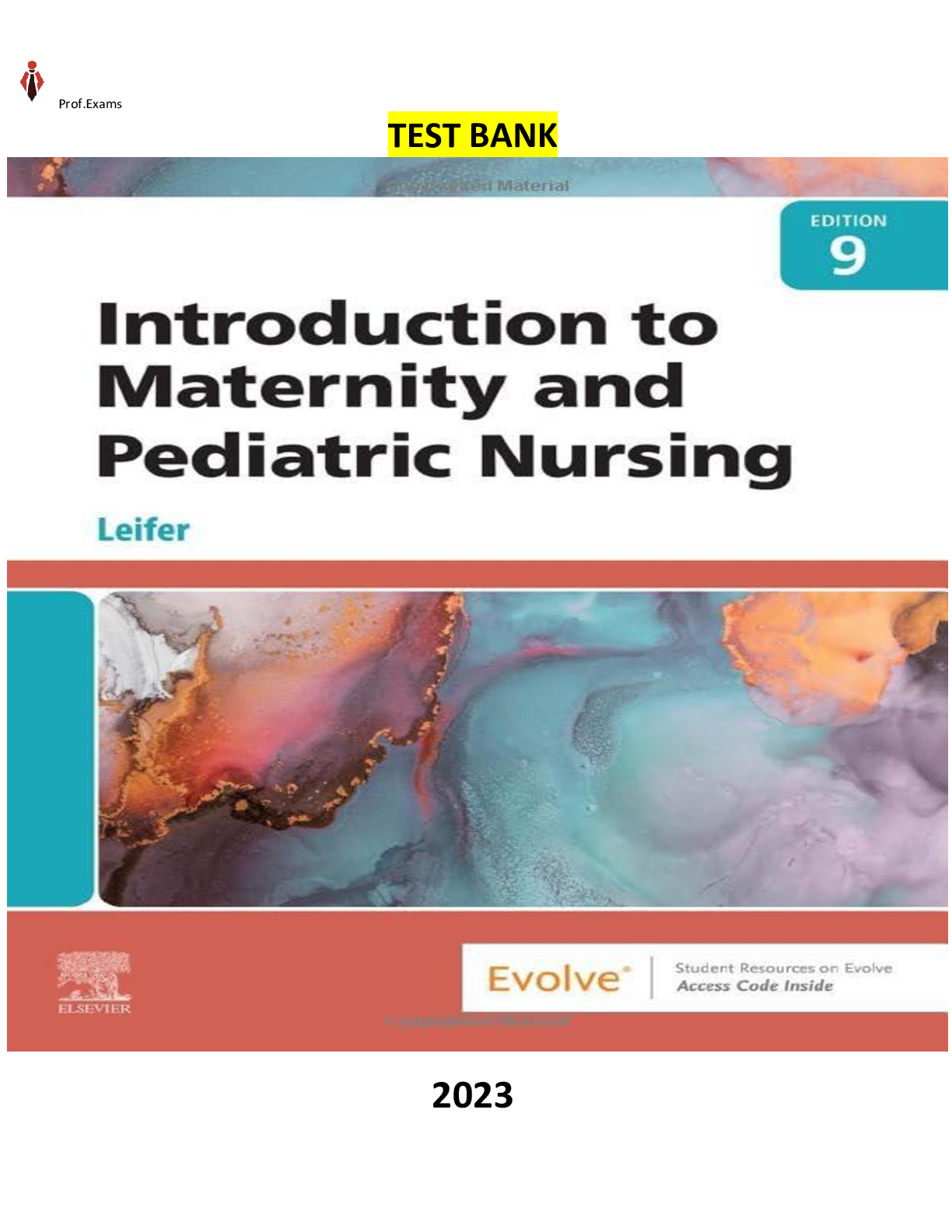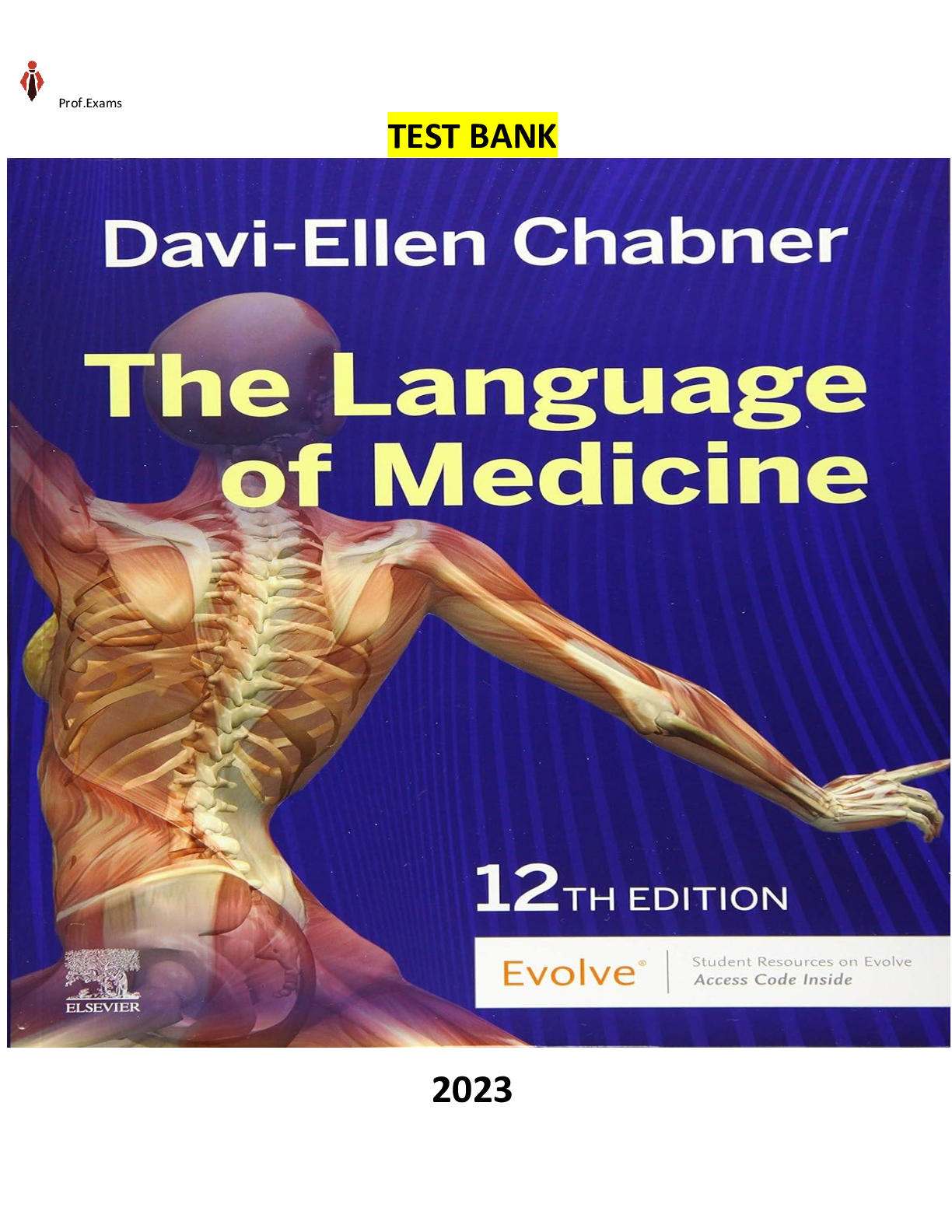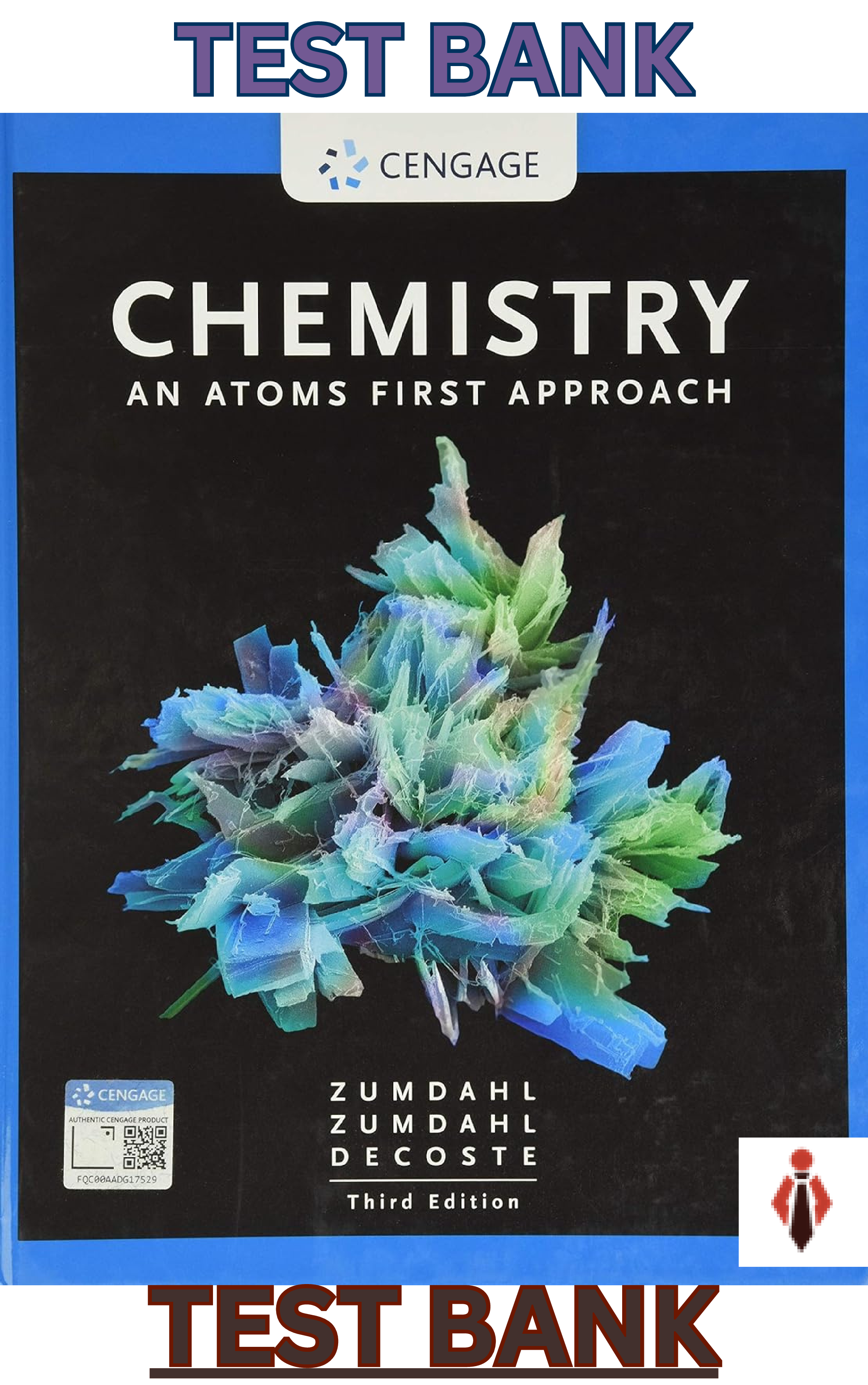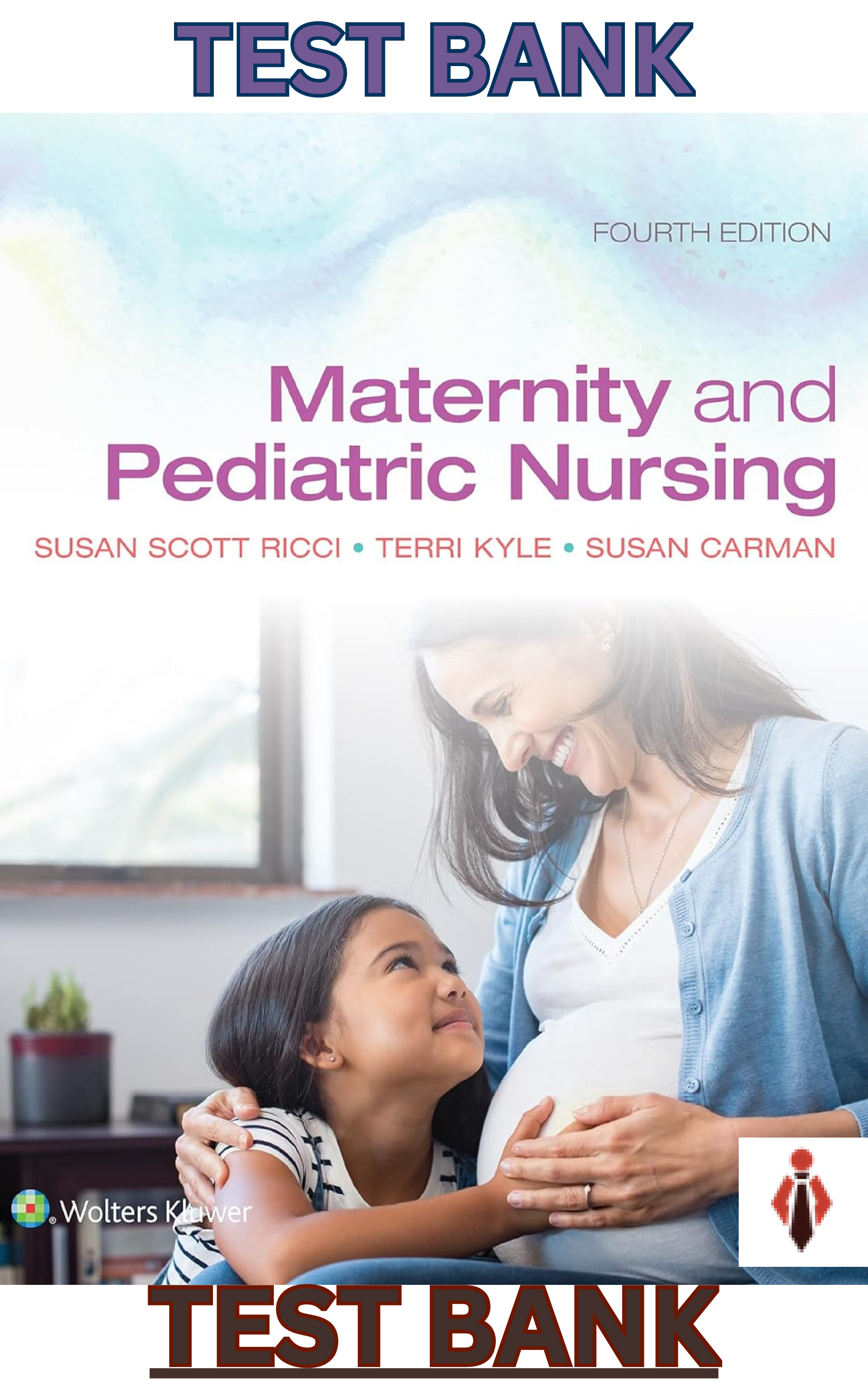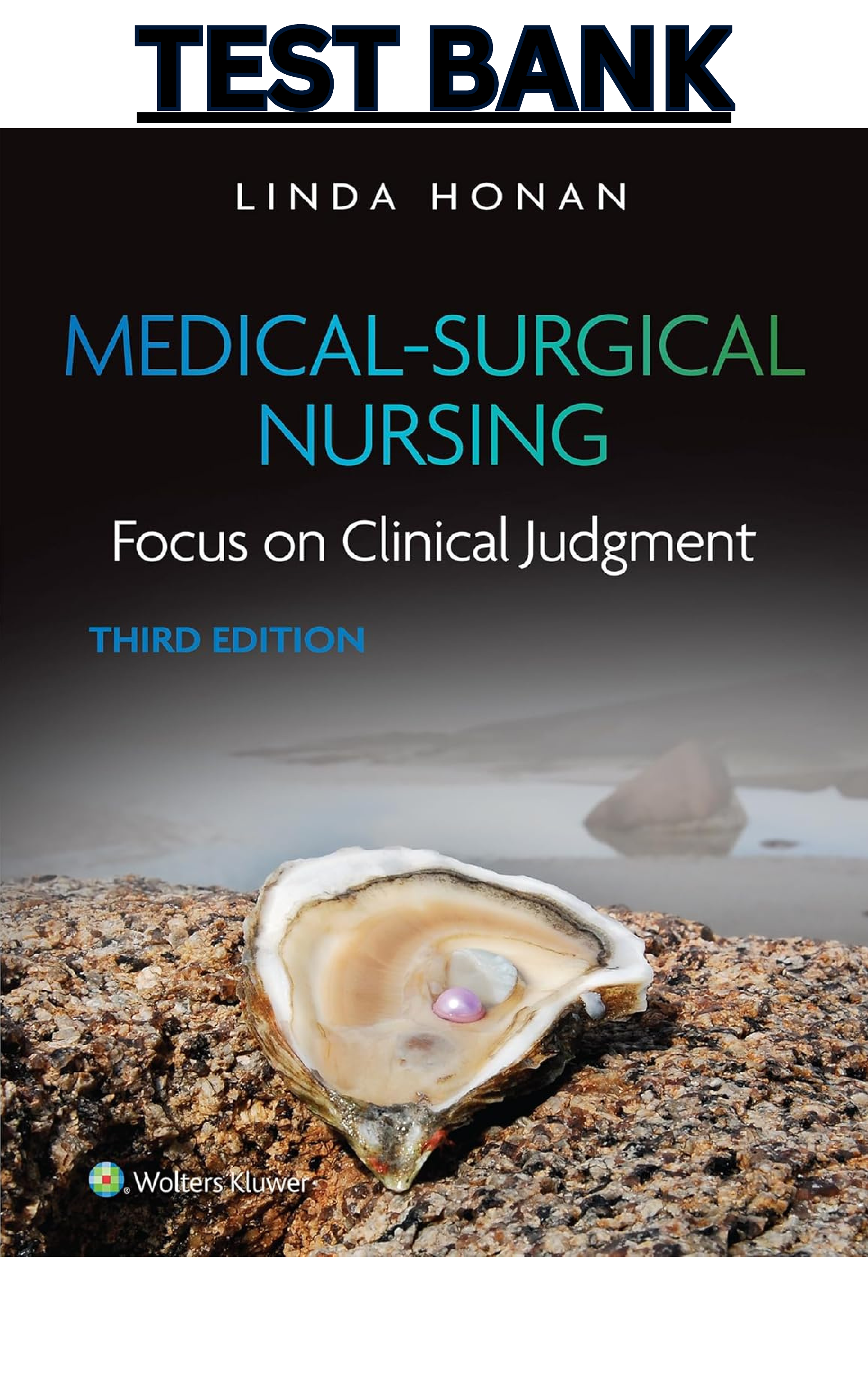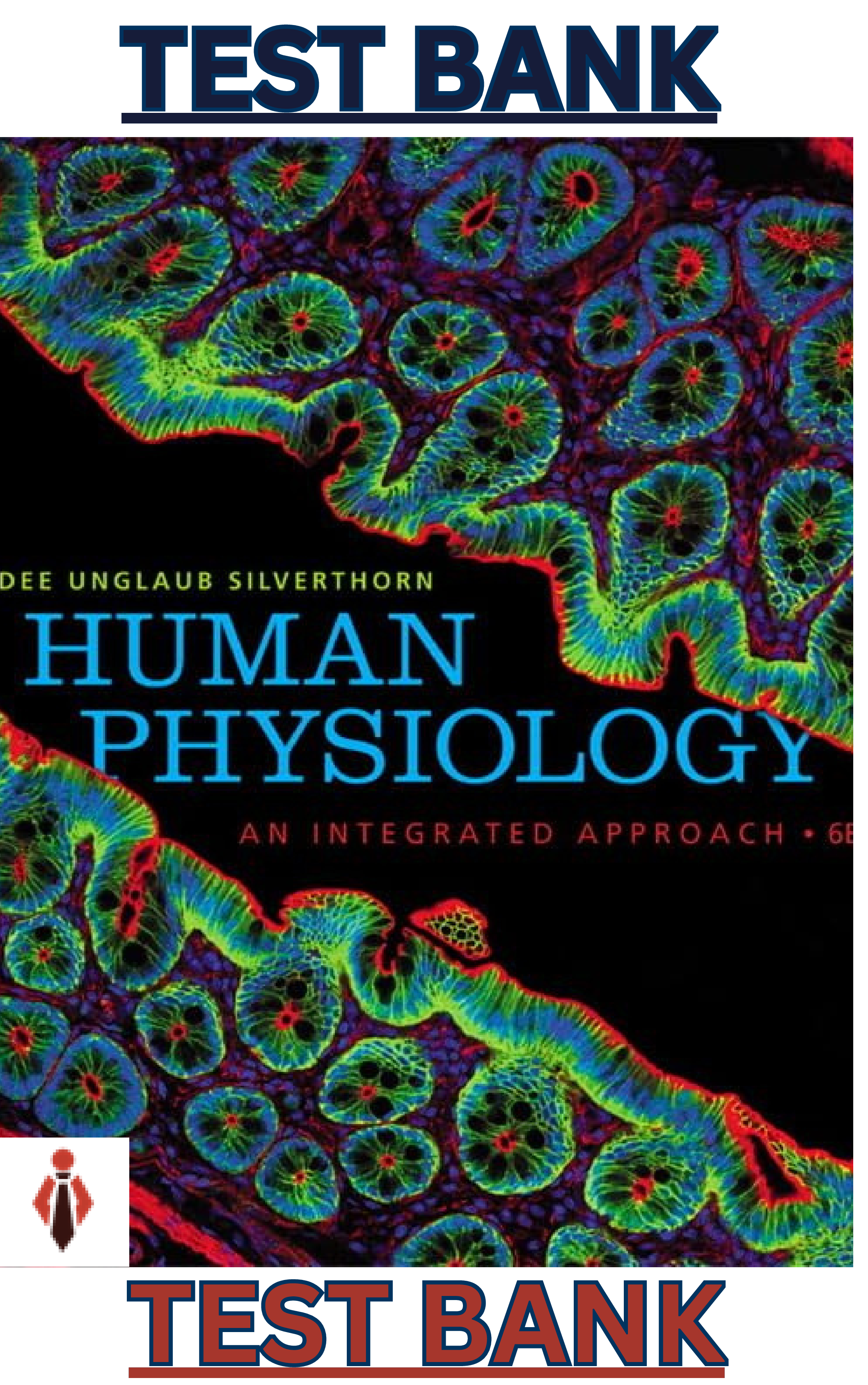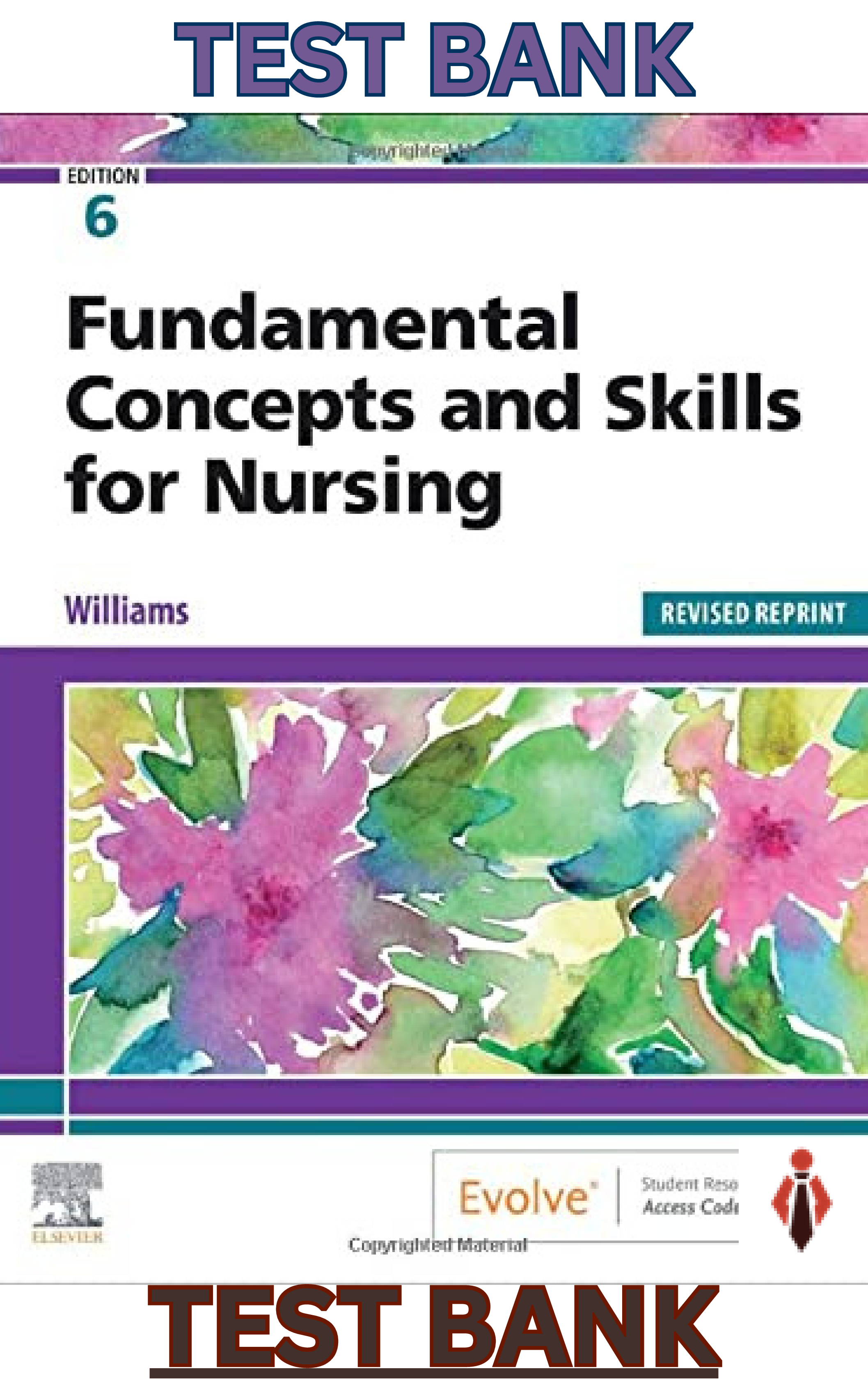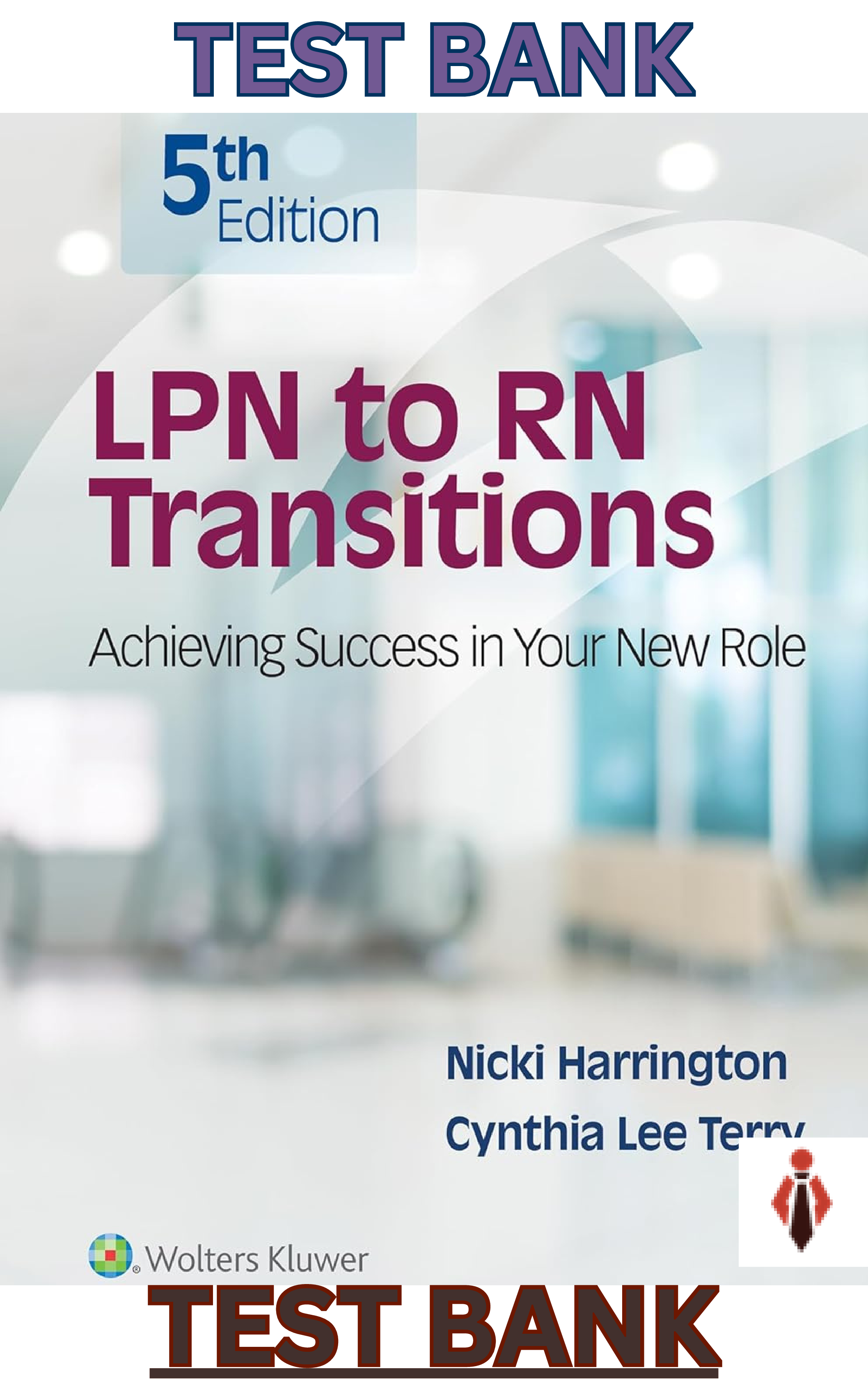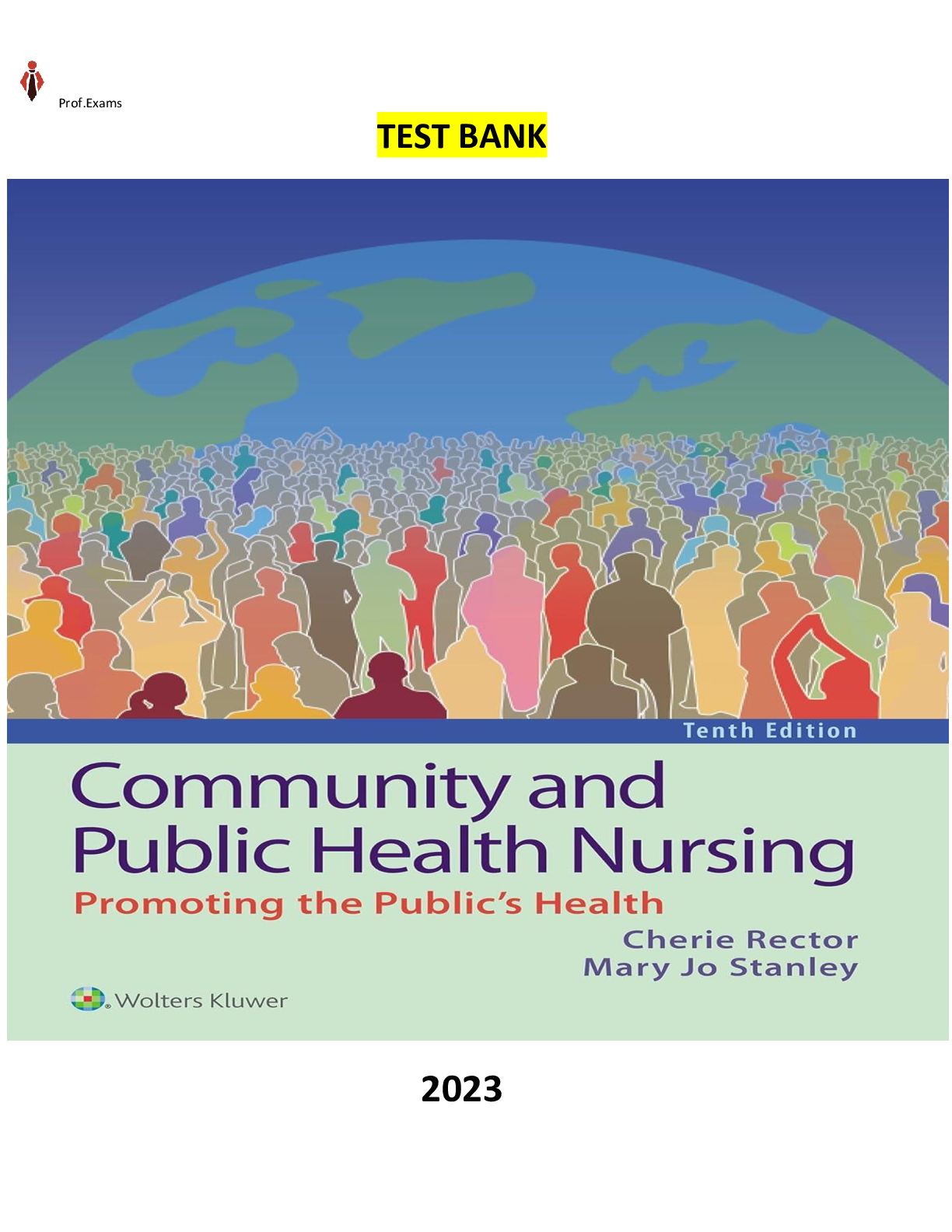*NURSING > TEST BANK > Test Bank for Medical-Surgical Nursing - Concepts for Clinical Judgment and Collaborative Care 11th (All)
Test Bank for Medical-Surgical Nursing - Concepts for Clinical Judgment and Collaborative Care 11th Edition by Donna D. Ignatavicius , Cherie R. Rebar , Nicole M. Heimgartner . Complete, Elaborated and Latest Testbank. ALL Chapters[1-65] included and Updated.
Document Content and Description Below
Test Bank for Medical-Surgical Nursing - Concepts for Clinical Judgment and Collaborative Care 11th Edition by Donna D. Ignatavicius , Cherie R. Rebar , Nicole M. Heimgartner . Complete, Elaborated an... d Latest Testbank. ALL Chapters[1-65] included and Updated. Test Bank - Med-Surg Nursing;Concepts for Clinical Judgment & Collaborative Care 11E - Ignatavicius #ClinicalNursingJudgment #MedicalSurgicalNursing #PatientCenteredCare #NursingFoundations #EmergencyCareConcepts #FluidElectrolyteBalance #PerioperativeManagement #ImmuneSystemProblems #RespiratoryTractManagement #CardiovascularSystemProblems #HematologicSystemManagement #NervousSystemProblems #SensorySystemManagement #MusculoskeletalSystemProblems #GastrointestinalSystemManagement #EndocrineSystemProblems #RenalUrinarySystemManagement #ReproductiveSystemProblems UNIT I: Essential Concepts of Medical-Surgical Nursing UNIT II: Concepts of Emergency Care and Disaster Preparedness UNIT III: Concepts of Fluid, Electrolyte, and Acid-Base Balance and Imbalance UNIT IV: Interprofessional Collaboration for Patients with Immunity Conditions UNIT V: Interprofessional Collaboration for Patients with Integumentary System Conditions UNIT VI: Interprofessional Collaboration for Patients with Respiratory System Conditions UNIT VII: Interprofessional Collaboration for Patients with Cardiovascular System Conditions UNIT VIII: Interprofessional Collaboration for Patients with Hematologic System Conditions UNIT IX: Interprofessional Collaboration for Patients with Nervous System Conditions UNIT X: Interprofessional Collaboration for Patients with Sensory System Conditions UNIT XI: Interprofessional Collaboration for Patients with Musculoskeletal System Conditions UNIT XII: Interprofessional Collaboration for Patients with Gastrointestinal System Conditions UNIT XIII: Interprofessional Collaboration for Patients with Endocrine System Conditions UNIT XIV: Interprofessional Collaboration for Patients with Renal/Urinary System Conditions UNIT XV: Interprofessional Collaboration for Patients with Reproductive System Conditions COMPLETE - Elaborated Test bank for Medical-Surgical Nursing - Concepts for Clinical Judgment and Collaborative Care 11ED.by Donna D. Ignatavicius , Cherie R. Rebar , Nicole M. Heimgartner COMPLETE - Elaborated Test bank for Medical-Surgical Nursing - Concepts for Clinical Judgment and Collaborative Care 11ED.by Donna D. Ignatavicius , Cherie R. Rebar , Nicole M. Heimgartner UNIT I: Essential Concepts of Medical-Surgical Nursing 1. Overview of Professional Nursing Concepts for Medical-Surgical Nursing 2. Clinical Judgment and Systems Thinking 3. Overview of Health Concepts for Medical-Surgical Nursing 4. Concepts of Care for Older Adults 5. Concepts of Care for Transgender and Non-Binary Patients 6. Assessment and Concepts of Care for Patients with Pain 7. Concepts of Rehabilitation for Chronic and Disabling Health Conditions 8. Concepts of Care for Patients at End-of-Life 9. Concepts of Care for Perioperative Patients UNIT II: Concepts of Emergency Care and Disaster Preparedness 10. Concepts of Emergency and Trauma Nursing 11. Concepts of Care for Patients with Common Environmental Emergencies 12. Concepts of Disaster Preparedness UNIT III: Concepts of Fluid, Electrolyte, and Acid-Base Balance and Imbalance 13. Concepts of Fluid and Electrolyte Balance and Imbalance 14. Concepts of Acid-Base Balance and Imbalance 15. Concepts of Infusion Therapy UNIT IV: Interprofessional Collaboration for Patients with Immunity Conditions 16. Concepts of Inflammation and Immunity 17. Concepts of Care for Patients with Allergy and Immunity Conditions 18. Concepts of Care for Patients with Cancer 19. Concepts of Care for Patients with Infection UNIT V: Interprofessional Collaboration for Patients with Integumentary System Conditions 20. Assessment of the Skin, Hair, and Nails 21. Concepts of Care for Patients with Conditions of the Skin, Hair, and Nails UNIT VI: Interprofessional Collaboration for Patients with Respiratory System Conditions 22. Assessment of the Respiratory System 23. Concepts of Care for Patients with Noninfectious Upper Respiratory Conditions 24. Concepts of Care for Patients with Noninfectious Lower Respiratory Conditions 25. Concepts of Care for Patients with Infectious Respiratory Conditions 26. Critical Care of Patients with Respiratory Emergencies UNIT VII: Interprofessional Collaboration for Patients with Cardiovascular System Conditions 27. Assessment of the Cardiovascular System 28. Concepts of Care for Patients with Dysrhythmias 29. Concepts of Care for Patients with Cardiac Conditions 30. Concepts of Care for Patients with Vascular Conditions 31. Critical Care of Patients with Shock 32. Critical Care of Patients with Acute Coronary Syndromes UNIT VIII: Interprofessional Collaboration for Patients with Hematologic System Conditions 33. Assessment of the Hematologic System 34. Concepts of Care for Patients with Hematologic Conditions UNIT IX: Interprofessional Collaboration for Patients with Nervous System Conditions 35. Assessment of the Nervous System 36. Concepts of Care for Patients with Conditions of the Central Nervous System: The Brain 37. Concepts of Care for Patients with Conditions of the Central Nervous System: The Spinal Cord 38. Critical Care of Patients with Neurologic Emergencies UNIT X: Interprofessional Collaboration for Patients with Sensory System Conditions 39. Assessment and Concepts of Care for Patients with Eye and Vision Conditions 40. Assessment and Concepts of Care for Patients with Ear and Hearing Conditions UNIT XI: Interprofessional Collaboration for Patients with Musculoskeletal System Conditions 41. Assessment of the Musculoskeletal System 42. Concepts of Care for Patients with Musculoskeletal Conditions 43. Concepts of Care for Patients with Arthritis and Total Joint Arthroplasty 44. Concepts of Care for Patients with Musculoskeletal Trauma UNIT XII: Interprofessional Collaboration for Patients with Gastrointestinal System Conditions 45. Assessment of the Gastrointestinal System 46. Concepts of Care for Patients with Oral Cavity and Esophageal Conditions 47. Concepts of Care for Patients with Stomach Conditions 48. Concepts of Care for Patients with Noninflammatory Intestinal Conditions 49. Concepts of Care for Patients with Inflammatory Intestinal Conditions 50. Concepts of Care for Patients with Liver Conditions 51. Concepts of Care for Patients with Conditions of the Biliary System and Pancreas 52. Concepts of Care for Patients with Malnutrition: Undernutrition and Obesity UNIT XIII: Interprofessional Collaboration for Patients with Endocrine System Conditions 53. Assessment of the Endocrine System 54. Concepts of Care for Patients with Pituitary and Adrenal Gland Conditions 55. Concepts of Care for Patients with Conditions of the Thyroid and Parathyroid Glands 56. Concepts of Care for Patients with Diabetes Mellitus UNIT XIV: Interprofessional Collaboration for Patients with Renal/Urinary System Conditions 57. Assessment of the Renal/Urinary System 58. Concepts of Care for Patients with Urinary Conditions 59. Concepts of Care for Patients with Kidney Conditions 60. Concepts of Care for Patients with Acute Kidney Injury and Chronic Kidney Disease UNIT XV: Interprofessional Collaboration for Patients with Reproductive System Conditions 61. Assessment of the Reproductive System 62. Concepts of Care for Patients with Breast Conditions 63. Concepts of Care for Patients with Gynecologic Conditions 64. Concepts of Care for Patients with Male Reproductive Conditions 65. Concepts of Care for Patients with Sexually Transmitted Infections Chapter 01: Overview of Professional Nursing Concepts for Medical-Surgical Nursing Ignatavicius: Medical-Surgical Nursing, 11th Edition MULTIPLE CHOICE 1. A new nurse is working with a preceptor on a medical-surgical unit. The preceptor advises the new nurse that which is the priority when working as a professional nurse? a. Attending to holistic client needs b. Ensuring client safety c. Not making medication errors d. Providing client-focused care ANS: B All actions are appropriate for the professional nurse. However, ensuring client safety is the priority. Health care errors have been widely reported for 25 years, many of which result in client injury, death, and increased health care costs. There are several national and international organizations that have either recommended or mandated safety initiatives. Every nurse has the responsibility to guard the client’s safety. The other actions are important for quality nursing, but they are not as vital as providing safety. Not making medication errors does provide safety, but is too narrow in scope to be the best answer. DIF: Understanding TOP: Integrated Process: Nursing Process: Intervention KEY: Client safety MSC: Client Needs Category: Safe and Effective Care Environment: Safety and Infection Control 2. A nurse is orienting a new client and family to the medical-surgical unit. What information does the nurse provide to best help the client promote his or her own safety? a. Encourage the client and family to be active partners. b. Have the client monitor hand hygiene in caregivers. c. Offer the family the opportunity to stay with the client. d. Tell the client to always wear his or her armband. ANS: A Each action could be important for the client or family to perform. However, encouraging the client to be active in his or her health care as a safety partner is the most critical. The other actions are very limited in scope and do not provide the broad protection that being active and involved does. DIF: Understanding TOP: Integrated Process: Teaching/Learning KEY: Client safety MSC: Client Needs Category: Safe and Effective Care Environment: Safety and Infection Control 3. A nurse is caring for a postoperative client on the surgical unit. The client’s blood pressure was 142/76 mm Hg 30 minutes ago, and now is 88/50 mm Hg. What action would the nurse take first? a. Call the Rapid Response Team. b. Document and continue to monitor. c. Notify the primary health care provider. d. Repeat the blood pressure in 15 minutes. ANS: A The purpose of the Rapid Response Team (RRT) is to intervene when clients are deteriorating before they suffer either respiratory or cardiac arrest. Since the client has manifested a significant change, the nurse would call the RRT. Changes in blood pressure, mental status, heart rate, temperature, oxygen saturation, and last 2 hours’ urine output are particularly significant and are part of the Modified Early Warning System guide. Documentation is vital, but the nurse must do more than document. The primary health care provider would be notified, but this is not more important than calling the RRT. The client’s blood pressure would be reassessed frequently, but the priority is getting the rapid care to the client. DIF: Applying TOP: Integrated Process: Communication and Documentation KEY: Rapid Response Team (RRT), Clinical judgment MSC: Client Needs Category: Physiological Integrity: Physiological Adaptation 4. A nurse wishes to provide client-centered care in all interactions. Which action by the nurse best demonstrates this concept? a. Assesses for cultural influences affecting health care. b. Ensures that all the client’s basic needs are met. c. Tells the client and family about all upcoming tests. d. Thoroughly orients the client and family to the room. ANS: A Showing respect for the client and family’s preferences and needs is essential to ensure a holistic or “whole-person” approach to care. By assessing the effect of the client’s culture on health care, this nurse is practicing client-focused care. Providing for basic needs does not demonstrate this competence. Simply telling the client about all upcoming tests is not providing empowering education. Orienting the client and family to the room is an important safety measure, but not directly related to demonstrating client-centered care. DIF: Understanding TOP: Integrated Process: Culture and Spirituality KEY: Client-centered care, Culture MSC: Client Needs Category: Psychosocial Integrity 5. A client is going to be admitted for a scheduled surgical procedure. Which action does the nurse explain is the most important thing the client can do to protect against errors? a. Bring a list of all medications and what they are for. b. Keep the provider’s phone number by the telephone. c. Make sure that all providers wash hands before entering the room. d. Write down the name of each caregiver who comes in the room. ANS: A Medication reconciliation is a formal process in which the client’s actual current medications are compared to the prescribed medications at the time of admission, transfer, or discharge. This National client Safety Goal is important to reduce medication errors. The client would not have to be responsible for providers washing their hands, and even if the client does so, this is too narrow to be the most important action to prevent errors. Keeping the provider’s phone number nearby and documenting everyone who enters the room also do not guarantee safety. DIF: Applying TOP: Integrated Process: Teaching/Learning KEY: Client safety, Informatics MSC: Client Needs Category: Safe and Effective Care Environment: Safety and Infection Control 6. Which action by the nurse working with a client best demonstrates respect for autonomy? a. Asks if the client has questions before signing a consent. b. Gives the client accurate information when questioned. c. Keeps the promises made to the client and family. d. Treats the client fairly compared to other clients. ANS: A Autonomy is self-determination. The client would make decisions regarding care. When the nurse obtains a signature on the consent form, assessing if the client still has questions is vital, because without full information the client cannot practice autonomy. Giving accurate information is practicing with veracity. Keeping promises is upholding fidelity. Treating the client fairly is providing social justice. DIF: Applying TOP: Integrated Process: Caring KEY: Ethics, Autonomy MSC: Client Needs Category: Safe and Effective Care Environment: Management of Care 7. A nurse asks a more seasoned colleague to explain best practices when communicating with a person from the lesbian, gay, bisexual, transgender, and questioning/queer (LGBTQ) community. What answer by the faculty is most accurate? a. Avoid embarrassing the client by asking questions. b. Don’t make assumptions about his or her health needs. c. Most LGBTQ people do not want to share information. d. No differences exist in communicating with this population. ANS: B Many members of the LGBTQ community have faced discrimination from health care providers and may be reluctant to seek health care. The nurse would never make assumptions about the needs of members of this population. Rather, respectful questions are appropriate. If approached with sensitivity, the client with any health care need is more likely to answer honestly. DIF: Understanding TOP: Integrated Process: Teaching/Learning KEY: Health care disparities, LGBTQ MSC: Client Needs Category: Psychosocial Integrity 8. A nurse is calling the on-call health care provider about a client who had a hysterectomy 2 days ago and has pain that is unrelieved by the prescribed opioid pain medication. Which statement comprises the background portion of the SBAR format for communication? a. “I would like you to order a different pain medication.” b. “This client has allergies to morphine and codeine.” c. “Dr. Smith doesn’t like nonsteroidal anti-inflammatory meds.” d. “This client had a vaginal hysterectomy 2 days ago.” ANS: B SBAR is a recommended form of communication, and the acronym stands for Situation, Background, Assessment, and Recommendation. Appropriate background information includes allergies to medications the on-call health care provider might order. Situation describes what is happening right now that must be communicated; the client’s surgery 2 days ago would be considered background. Assessment would include an analysis of the client’s problem; none of the options has assessment information. Asking for a different pain medication is a recommendation. Recommendation is a statement of what is needed or what outcome is desired. DIF: Applying TOP: Integrated Process: Communication and Documentation KEY: Teamwork and collaboration, SBAR MSC: Client Needs Category: Safe and Effective Care Environment: Management of Care 9. A nurse working on a cardiac unit delegated taking vital signs to an experienced assistive personnel (AP). Four hours later, the nurse notes that the client’s blood pressure taken by the AP was much higher than previous readings, and the client’s mental status has changed. What action by the nurse would most likely have prevented this negative outcome? a. Determining if the AP knew how to take blood pressure b. Double-checking the AP by taking another blood pressure c. Providing more appropriate supervision of the AP d. Taking the blood pressure instead of delegating the task ANS: C Supervision is one of the five rights of delegation and includes directing, evaluating, and following up on delegated tasks. The nurse would either have asked the AP about the vital signs or instructed the AP to report them right away. An experienced AP would know how to take vital signs and the nurse would not have to assess this at this point. Double-checking the work defeats the purpose of delegation. Vital signs are within the scope of practice for a AP and are permissible to delegate. The only appropriate answer is that the nurse did not provide adequate instruction to the AP. DIF: Analyzing TOP: Integrated Process: Communication and Documentation KEY: Teamwork and collaboration, Delegation MSC: Client Needs Category: Safe and Effective Care Environment: Management of Care 10. A newly graduated nurse in the hospital states that because of being so new, participation in quality improvement (QI) projects is not wise. What response by the precepting nurse is best? a. “All staff nurses are required to participate in quality improvement here.” b. “Even being new, you can implement activities designed to improve care.” c. “It’s easy to identify what indicators would be used to measure quality.” d. “You should ask to be assigned to the research and quality committee.” ANS: B The preceptor would try to reassure the nurse that implementing QI measures is not out of line for a newly licensed nurse. Simply stating that all nurses are required to participate does not help the nurse understand how that is possible and is dismissive. Identifying indicators of quality is not an easy, quick process and would not be the best place to suggest a new nurse to start. Asking to be assigned to the QI committee does not give the nurse information about how to implement QI in daily practice. DIF: Applying TOP: Integrated Process: Communication and Documentation KEY: Systems thinking, Quality improvement MSC: Client Needs Category: Safe and Effective Care Environment: Management of Care 11. A nurse is talking with a co-worker who is moving to a new state and needs to find new employment there. What advice by the nurse is best? a. Ask the hospitals there about standard nurse–client ratios. b. Choose the hospital that has the newest technology. c. Find a hospital that has achieved Magnet status. d. Work in a facility affiliated with a medical or nursing school. ANS: C Client Magnet status is awarded by The Joint Commission (TJC) and certifies that nurses can demonstrate how best current evidence guides their practice. New technology doesn’t necessarily mean that the hospital is safe. Affiliation with a health profession school has several advantages, but safety is most important. DIF: Understanding TOP: Integrated Process: Communication and Documentation KEY: Evidence-based practice, Magnet status MSC: Client Needs Category: Safe and Effective Care Environment: Safety and Infection Control MULTIPLE RESPONSE 1. A nurse manager wishes to ensure that the nurses on the unit are practicing at their highest levels of competency. Which areas would the manager assess to determine if the nursing staff demonstrate competency according to the Institute of Medicine (IOM) report Health Professions Education: A Bridge to Quality? (Select all that apply.) a. Collaborating with an interprofessional team b. Implementing evidence-based care c. Providing family-focused care d. Routinely using informatics in practice e. Using quality improvement in client care f. Formalizing systems thinking when implementing care ANS: A, B, D, E The IOM report lists five broad core competencies that all health care providers should practice. These include collaborating with the interprofessional team, implementing evidence-based practice, providing patient-focused care, using informatics in client care, and using quality improvement in client care. Systems thinking is required for quality improvement but is not a specified part of the IOM report. DIF: Remembering TOP: Integrated Process: Nursing Process: Assessment KEY: Competencies, Institute of Medicine (IOM) MSC: Client Needs Category: Safe and Effective Care Environment: Safety and Infection Control 2. A nurse is interested in making interprofessional work a high priority. Which actions by the nurse best demonstrate this skill? (Select all that apply.) a. Consults with other disciplines on client care. b. Coordinates discharge planning for home safety. c. Participates in comprehensive client rounding. d. Routinely asks other disciplines about client progress. e. Shows the nursing care plans to other disciplines. f. Delegate tasks to unlicensed personnel appropriately. ANS: A, B, C, D, F Collaborating with the interprofessional team involves planning, implementing, and evaluating client care as a team with all other involved disciplines included. Simply showing other caregivers the nursing care plan is not actively involving them or collaborating with them. DIF: Applying TOP: Integrated Process: Communication and Documentation KEY: Teamwork and collaboration, Interprofessional team MSC: Client Needs Category: Safe and Effective Care Environment: Management of Care 3. The nurse utilizing evidence-based practice (EBP) considers which factors when planning care? (Select all that apply.) a. Cost-saving measures b. Nurse’s expertise c. Client preferences d. Research findings e. Values of the client f. Plan-do-study-act model ANS: B, C, D, E EBP consists of utilizing current evidence, the client’s values and preferences, and the nurse’s expertise when planning care. It does not include cost-saving measures. The PDSA model is a systematic model for quality improvement, but is not a specific component of EBP. DIF: Remembering TOP: Integrated Process: Nursing Process: Planning KEY: Evidence-based practice (EBP) MSC: Client Needs Category: Safe and Effective Care Environment: Management of Care 4. A nurse manager wants to improve hand-off communication among the staff. What actions by the manager would best help achieve this goal? (Select all that apply.) a. Attend hand-off rounds to coach and mentor. b. Create a template of suggested topics to include in report. c. Encourage staff to ask questions during hand-off. d. Give raises based on compliance with reporting. e. Provide education on the SBAR method of communication ANS: A, B, C, E The SBAR method of communication has been identified as an excellent method of communication between health care professionals. It is a formalized structure consisting of Situation, Background, Assessment, and Recommendation/Request. Using a formalized mechanism for communication helps ensure successful hand-off and fewer client errors. When establishing this new format for report, the most helpful actions by the manager would be to provide initial education on the process, develop a template with suggested topics under each heading, attend rounds to coach and mentor, and encourage staff to ask questions to clarify information. Basing. [Show More]
Last updated: 1 week ago
Preview 1 out of 596 pages
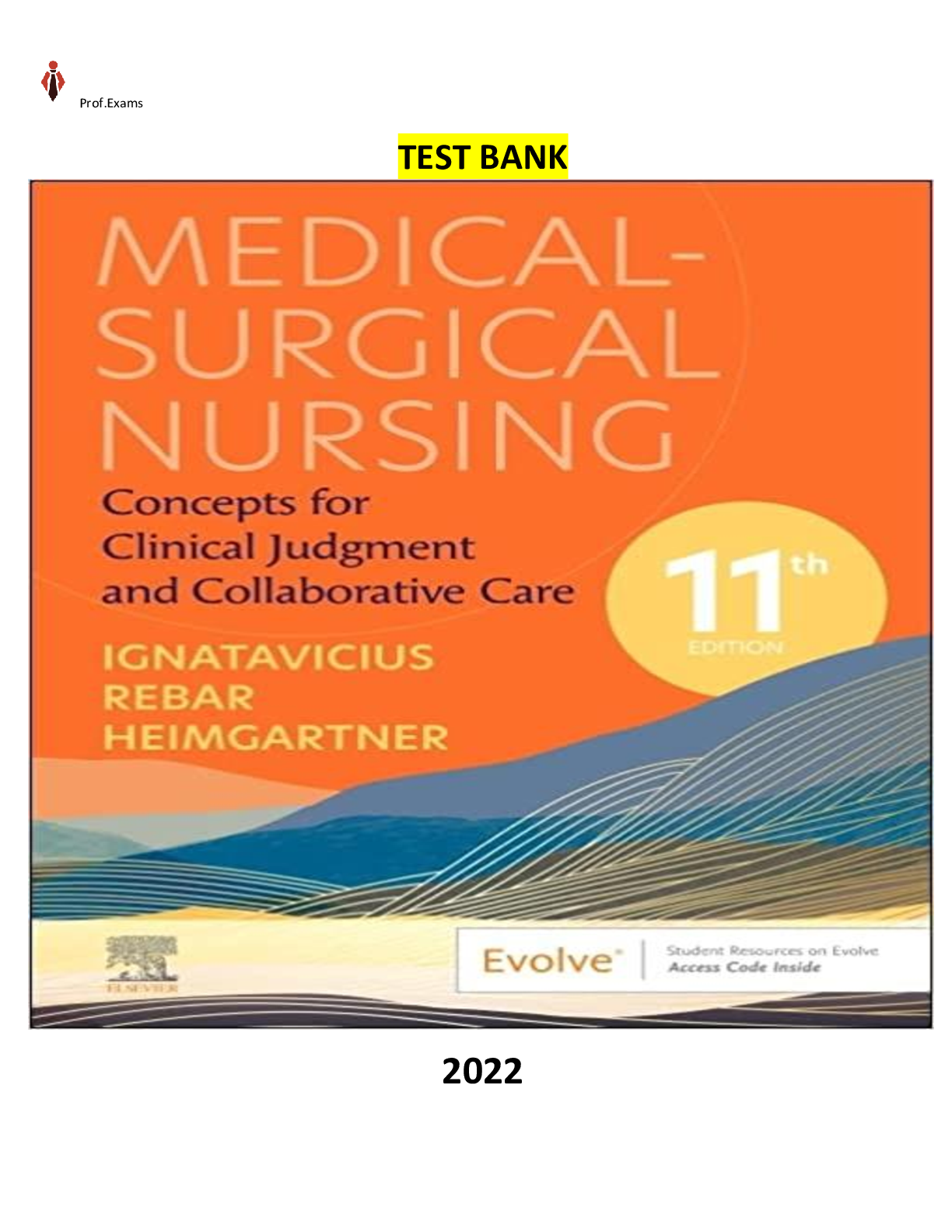
Reviews( 0 )
Document information
Connected school, study & course
About the document
Uploaded On
Apr 01, 2023
Number of pages
596
Written in
Additional information
This document has been written for:
Uploaded
Apr 01, 2023
Downloads
0
Views
78


